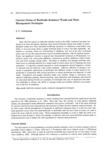Current Status of Herbicide-Resistant Weeds and Their Management Strategies
JIRCAS international symposium series
| ISSN | 13406108 |
|---|---|
| 書誌レコードID(総合目録DB) | AA1100908X |

本文フルテキスト
intlsymp-4_124-132.pdf408.37 KB
Since the first reports of herbicide-resistant weeds in the 1960s, resistance has been confirmed in at least 100 species, affecting many diverse herbicide classes and modes of action. Resistant weeds have been identified worldwide, generally in continuous monoculture crop fields, or non-crop areas, where a single herbicide mode of action was used repeatedly. Resistance to triazines, which are Photosystem II inhibitors, was one of the first confirmed cases, and it is now the most prevalent type of herbicide resistance, with 58 resistant species. Fewer, but significant numbers of species have documented resistance to Photosystem I inhibitors, acetyl CoA carboxylase inhibitors, acetolactate synthase inhibitors, tubulin inhibitors, and auxin analogs, among others. Strategies to minimize and manage herbicide resistance focus on reducing selection by a single mode of action alone, and on depleting the weed population. A long-term, planned approach to weed management should integrate a variety of chemical and non-chemical weed control methods. Judicious selection of mixture, rotational, or sequential applications of herbicides with different modes of action should be implemented in conjunction with cultural practices to reduce production and dispersal of weed seeds. Competitive crop stands, weed-free seeds, crop rotation, tillage or cultivation, nonselective herbicides, grazing, delayed planting, clean machinery and equipment, and removal of weed seeds during harvest are examples of techniques that may be employed with selective herbicides to enhance the ability to manage weeds and maintain efficient crop production in the face of resistance.
| 作成者 | J. C. Cotterman |
|---|---|
| 著者キーワード | herbicide-resistant weeds resistance management strategies |
| 公開者 | Japan International Research Center for Agricultural Sciences |
| オンライン掲載日 | |
| 号 | 4 |
| 開始ページ | 124 |
| 終了ページ | 132 |
| 言語 | eng |
